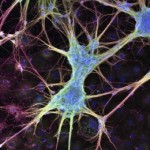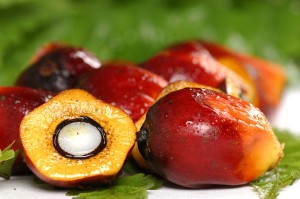It has been reported that alpha-tocopherol (alpha-Toc), a vitamin E analog, is effective for treatment of non-alcoholic steatohepatitis (NASH). However, it is unknown whether or not other vitamin E analogs are effective. Therefore we designed a new rat model of steatohepatitis induced by tumor necrosis factor-alpha (TNF-alpha) stimulation, and used it to investigate the effects of vitamin E analogs. The rat liver triglyceride content increased with the dosage of TNF-alpha/d-galactosamine (GalN), but was suppressed by intake of both tocotrienol (T3) and alpha-tocopherol. Moreover, lipid peroxides (thiobarbituric acid-reactive substances) level in the liver level was also lower in both groups after tocotrienol and alpha-Toc intake. Intake of both tocotrienol and alpha-tocopherol also tended to control the increase of liver damage marker activity. In the tocotrienol and alpha-tocopherol groups, increases of inflammatory cytokines mRNA expression in the liver were inhibited, and these effects were considered to contribute to improvement of inflammation and fibrosis. The expression of mRNAs for inflammatory cytokines in rat primary hepatocytes was increased by TNF-alpha stimulation, but was inhibited by addition of alpha-tocotrienol and gamma-tocotrienol. Transforming growth factor-beta1 mRNA expression in particular was significantly inhibited by gamma-tocotrienol. These findings suggest that tocotrienol species are effective for amelioration of steatohepatitis, and that tocotrienol and alpha-tocopherol exert a synergistic effect.
Blog Archives
Mobilization of progenitor cells into peripheral blood by gamma-tocotrienol: A promising radiation countermeasure
Ray, S.,Kulkarni, S. S., Chakraborty, K.,Pessu, R.,Hauer-Jensen, M.,Kumar, K. S.,Ghosh, S. P.
Int Immunopharmacol 2013;15(3):557-64
Gamma-tocotrienol (GT3), a vitamin E isoform, is shown to induce high levels of granulocyte colony stimulating factor (G-CSF) in mice. G-CSF is a key cytokine used for stimulation of hematopoiesis, and mobilization of hematopoietic stem and progenitor cells into peripheral blood. GT3 is also shown to induce vascular endothelial growth factor (VEGF), another important cytokine necessary for vasculogenesis and endothelial progenitor mobilization. Since GT3 induces both these cytokines, we tested whether GT3 mobilizes hematopoietic and endothelial progenitors in mice. GT3 (200mg/kg) was injected in 10-week-old CD2F1 mice and mobilization of progenitors in peripheral blood was analyzed at 24, 48, and 72h post-administration. Circulating hematopoietic progenitor cells (HPCs, Lin(-), cKit(+)), endothelial progenitor cells (EPCs, Lin(-), CD34(+), Flk(+)), and stromal progenitor cells (SPCs, Lin(-), CD29(+), CD105(+)) in peripheral blood mononuclear cells (PBMCs) were analyzed simultaneously by flow cytometry. Mobilized HPCs, EPCs and SPCs in PBMC were also measured by colony-forming unit (CFU) assay in progenitor-specific media. Three groups of mice received vehicle, GT3 and GT3 plus AMD3100, a receptor antagonist used to enhance mobilization. GT3 induced significant mobilization of all three progenitor cell types compared to vehicle in peripheral blood; AMD3100 enhanced GT3-induced mobilization even further. Mobilization of progenitor cells in peripheral blood by GT3 indicates that GT3 can be used as an alternative to G-CSF and VGEF to mobilize HPCs and EPCs.
Supplementation with tocotrienol-rich fraction alters the plasma levels of Apolipoprotein A-I precursor, Apolipoprotein E precursor, and C-reactive protein precursor from young and old individuals
Heng, E. C., Karsani, S. A., Abdul Rahman, M., Abdul Hamid, N. A., Hamid, Z., Wan Ngah, W. Z.
2013
Objective: Tocotrienol possess beneficial effects not exhibited by tocopherol. In vitro studies using animal models have suggested that these effects are caused via modulation of gene and protein expression. However, human supplementation studies using tocotrienol-rich isomers are limited. This study aims to identify plasma proteins that changed in expression following tocotrienol-rich fraction (TRF) supplementation within two different age groups.
METHODS: Subjects were divided into two age groups-32 +/- 2 (young) and 52 +/- 2 (old) years old. Four subjects from each group were assigned with TRF (78 % tocotrienol and 22 % tocopherol, 150 mg/day) or placebo capsules for 6 months. Fasting plasma were obtained at 0, 3, and 6 months. Plasma tocopherol and tocotrienol levels were determined. Plasma proteome was resolved by 2DE, and differentially expressed proteins identified by MS. The expressions of three proteins were validated by Western blotting.
RESULTS: Six months of TRF supplementation significantly increased plasma levels of tocopherols and tocotrienols. Proteins identified as being differentially expressed were related to cholesterol homeostasis, acute-phase response, protease inhibitor, and immune response. The expressions of Apolipoprotein A-I precursor, Apolipoprotein E precursor, and C-reactive protein precursor were validated. The old groups showed more proteins changing in expression.
CONCLUSIONS: TRF appears to not only affect plasma levels of tocopherols and tocotrienols, but also the levels of plasma proteins. The identity of these proteins may provide insights into how TRF exerts its beneficial effects. They may also be potentially developed into biomarkers for the study of the effects and effectiveness of TRF supplementation.
Eliminating drug resistant breast cancer stem-like cells with combination of simvastatin and gamma-tocotrienol
Gopalan, A., Yu, W., Sanders, B. G., Kline, K.
Cancer Lett 2013;328:285-96
Present study shows that drug resistant human breast cancer cells are enriched in cancer stem-like cells (CSCs) and express elevated levels of Stat-3 signaling mediators, which contribute to CSC enrichment. Simvastatin (SVA) and gamma-tocotrienol (gammaT3) eliminate enriched CSCs and suppress expression of Stat-3 signaling mediators via inhibition of the mevalonate pathway and activation of de novo ceramide synthesis pathway, respectively. Combination of SVA+gammaT3 at low doses enhanced these actions via inhibition of the mevalonate pathway. Data demonstrate that SVA and gammaT3 alone or in combination possess the ability to eliminate CSCs in drug resistant human breast cancer cells.
 Studies published in international peer-reviewed journals have highlighted Vitamin E’s neuroprotective benefits, an activity largely attributed to Vitamin E’s antioxidant properties. Oxidative stress plays a major role in the development and progression of AD. Results from the Rotterdam Study, one of the largest study to date on the effects of dietary antioxidant intake on dementia risk in over 5,000 subjects have shown that high intake of vitamin E- rich food sources can modestly reduce the long-term risk of dementia and AD. [1]
Studies published in international peer-reviewed journals have highlighted Vitamin E’s neuroprotective benefits, an activity largely attributed to Vitamin E’s antioxidant properties. Oxidative stress plays a major role in the development and progression of AD. Results from the Rotterdam Study, one of the largest study to date on the effects of dietary antioxidant intake on dementia risk in over 5,000 subjects have shown that high intake of vitamin E- rich food sources can modestly reduce the long-term risk of dementia and AD. [1]
A series of clinical studies by Mangialasche et al have shown that high plasma levels of vitamin E tocotrienol is associated with reduced Alzheimer Disease risk. [2]Recently, Mangialasche et al confirms vitamin E’s neuroprotective abilities this time in subjects with varying degrees of cognitive impairment. In the AdNeuroMed Trial, a longitudinal multi-centred study, Mangialsche et al focused not just on alpha-tocopherol levels but also measured tocotrienol levels and combined these with imaging measures to help differentiate patients with AD from those without. Results from the AdNeuroMed Study has shown that plasma levels of vitamin E tocotrienols when taken together with MRI measures can help enhance the accuracy of differentiating patients with varying degree of cognitive impairment. Interestingly, this multi-modal approach can also help predict the progression of milder forms of cognitive impairment to Alzheimer’s Disease (AD). This combined MRI and Vitamin E biomarker approach is also more readily available and less invasive compared to conventional imaging measures e.g. MRI/PET. [3]
Tocotrienol has over 40 to 60 times more powerful antioxidant activity than alpha-tocopherol. [4] Palm tocotrienol significantly alleviates oxidative stress not only by its potent free radical scavenging properties but also by interacting directly and strongly with antioxidant enzymes such as superoxide dismutase and glutathione peroxidase. [5] Vitamin E tocotrienol particularly its alpha isoform is closely associated with neuroprotective activity. [6] Alpha-tocotrienol can readily reach high concentrations in the blood after oral supplementation suggesting that dietary intake of tocotrienols can adequately support neuroprotection. [7]
Apart from highlighting tocotrienol’s role as a potential nutritional biomarker in patients with AD, results from these studies show that supplementation with tocotrienol may reduce the long-term risk of dementia and AD and may adequately protect against full progression of AD in those with mild cognitive impairment.
References
1. Devore EE, et al. Dietary antioxidants and long-term risk of dementia. Arch Neurol, 2010. 67(7): 819-25.
4. Serbinova E, K.V., Han D and Packer L.Free radical recycling and intramembrane mobility in the antioxidant properties of alpha-tocopherol and alpha-tocotrienol. . Free Radic Biol Med 1991. 10(5):263-75. .
6. Sen, C.K., C. Rink, and S. Khanna. Palm oil-derived natural vitamin E alpha-tocotrienol in brain health and disease. J Am Coll Nutr, 2010. 29(3 Suppl):314S-323S.
7. Patel, V., et al., Natural vitamin E alpha-tocotrienol: retention in vital organs in response to long-term oral supplementation and withdrawal. Free Radic Res, 2006. 40(7):763-71
High Intake of Vitamin E Tocotrienol May Reduce Alzheimer’s Risk
 Studies published in international peer-reviewed journals have highlighted Vitamin E’s neuroprotective benefits, an activity largely attributed to Vitamin E’s antioxidant properties. Oxidative stress plays a major role in the development and progression of AD. Results from the Rotterdam Study, one of the largest study to date on the effects of dietary antioxidant intake on dementia risk in over 5,000 subjects have shown that high intake of vitamin E- rich food sources can modestly reduce the long-term risk of dementia and AD.
Studies published in international peer-reviewed journals have highlighted Vitamin E’s neuroprotective benefits, an activity largely attributed to Vitamin E’s antioxidant properties. Oxidative stress plays a major role in the development and progression of AD. Results from the Rotterdam Study, one of the largest study to date on the effects of dietary antioxidant intake on dementia risk in over 5,000 subjects have shown that high intake of vitamin E- rich food sources can modestly reduce the long-term risk of dementia and AD.
 In the show’s January 3, 2013 episode, Dr Oz and his guest, Bryce Wylde, recommend red palm oil particularly for its palm tocotrienol, a novel form of vitamin E found in the palm fruit. On his show Dr Oz called the red palm oil as the “most miraculous find of 2013”.
In the show’s January 3, 2013 episode, Dr Oz and his guest, Bryce Wylde, recommend red palm oil particularly for its palm tocotrienol, a novel form of vitamin E found in the palm fruit. On his show Dr Oz called the red palm oil as the “most miraculous find of 2013”.
Power-Packed Contents
Red palm oil’s health promoting properties are largely attributed to its high antioxidant and anti-inflammatory contents. Red palm oil is a rich source of tocotrienol, a powerful form of vitamin E, lycopene and carotenoids, the latter being responsible for the oil’s distinctive red color in its unprocessed state.
Red Palm Oil and Cardiovascular Health
Red palm oil has repeatedly stunned researchers with its heart-protective and cholesterol-lowering properties. Studies have shown that adding palm oil in the diet can reduce plaque build-up in arteries and, therefore, reverse the process of plaque and prevent blockages formation within blood vessel walls. Science now understands that inflammation in the artery lining is what causes cholesterol to deposit in the first place. So, it makes sense that the protective effects come from the high antioxidant, anti-inflammatory content of the red palm oil which works to quench free radicals and keep inflammation under control. Apart from helping tear away plaque from blood vessel walls, red palm oil also helps maintain healthy blood pressure and cholesterol levels.
Red Palm Oil and Brain Health
Alpha-tocotrienol, one of the natural vitamin E forms found in high amounts in red palm oil is known for its neuro-protective properties. Studies funded by the National Institutes of Health (NIH) have shown that alpha-tocotrienol can help reduce the effects of stroke by 50%. When it comes to your brain, the special form of vitamin-E (tocotrienol) in red palm oil stops destructive damage and improves blood flow to brain cells, which can also help to prevent Alzheimer’s disease and dementia.
 Oil Palm Fruit (Eleais guinensis)
Oil Palm Fruit (Eleais guinensis)
Red Palm Oil as Anti-Cancer Food
The high antioxidant content of red palm oil makes it a potent anti-cancer food. Though tocotrienols can be found in rice bran, barley and wheat, red palm oil is the richest source of tocotrienol. Research suggests that this form of vitamin E may help fight skin, stomach, pancreas, liver, lung, colon, prostate, breast, and other cancers.
Other Health Benefits of Red Palm Oil
Research is showing that the antioxidant power of red palm oil can be of help in protecting against a variety of health problems, including osteoporosis, asthma, cataracts, macular degeneration, arthritis, and liver disease. It can even slow down the premature aging processes by protecting the skin against damaging UV rays.
Additionally, research has shown that red palm oil promotes nutrient utilization, improves liver detoxification pathways and improves immune function.
Scientists have found tocotrienol supplementation lower plasma triglyceride levels in patients undergoing chronic hemodialysis.
The study was conducted by Professor Pramod Khosla’s group in Wayne State University. End-stage renal disease patients on chronic (at least 3 months prior to the study) dialysis treatment were recruited from a local dialysis clinic in Detroit. 81 Patients were randomized to receive either 180 mg tocotrienol rich fraction or placebo daily for 16 weeks. The patient compliance was measured by pill counting. After 12 weeks supplementation, the group receiving tocotrienol supplementation have decreased plasma triglyceride levels from 144 ± 91mg/dL to 113± 47 mg/dL (p <0.05). The triglyceride levels remained low (103± 45 mg/dL) at week 16. In the control group, the plasma triglyceride levels were unchanged.
Triglycerides are produced from energy sources like carbohydrates. High plasma triglyceride levels (> 150 mg/dL) indicate increased risk of cardiovascular diseases. In end-stage renal disease patients, dyslipidemia is highly prevalent with elevated plasma triglyceride levels. This study indicated the lipid-regulation and potential cardio-protection effect of tocotrienol in these patients.
The triglyceride-lowering effect of tocotrienol observed in this clinical study agrees with a previous publication by Davos Life Science, in which supplementation with 120 mg γδ-tocotrienol in 10 hypercholesterolemic subjects for 8 weeks led to a 28% reduction in plasma triglyceride levels.
Both the tocotrienol supplementation group and the control group have decreased levels of total cholesterol, higher levels of high density lipoprotein cholesterol (HDLC) and decreased levels of low-density lipoprotein cholesterol (LDLC) at week 16. This could be due to the effect of the cholesterol-lowering drug statin of which 30-40% of the patients were taking concurrently.
This study reinforced the cardiovascular benefits of palm-derived tocotrienols in lowering triglyceride levels in subjects with mild to moderate dyslipidemia.
Reference:
Alzheimer’s disease (AD) affects millions of people in the world with symptoms of deteriorating memory and loss of bodily functions. Currently there is no cure for this disease and researches focus on preventing the onset and slowing the progression of the disease.
A clinical study published in JAMA found that patients with mild to moderate Alzheimer’s disease benefited from high dose of Vitamin E supplementation with delayed disease progression over a study period of 5 years.
613 patients participated in the Trial of Vitamin E and Memantine in Alzheimer’s disease (TEAM-AD). The participants were randomized to receive either 200O IU/d α-tocopherol, 20 mg/d of memantine (NMDA antagonist), the combination, or placebo. The participants were assessed every 6 months for functional abilities to perform daily living activities such as dressing or bathing, cognitive function and dementia severity, memory, language and praxis functions in AD using a range of questionnaires and instruments. The time on which caregivers spend assisting AD patients in daily activities were also surveyed. Drug compliance was monitored by measuring the serum levels of α-tocopherol and memantine.
The patients receiving Vitamin E have a delay of 19% per year or approximately 6.2 months in the clinical progression compared to the control, followed by a reduction of 2 hour/d of caregiver time. Despite the high dose of α-tocopherol used in this study, the annual mortality rate in the group receiving α-tocopherol (7.3%) was not increased compared to those in the placebo group (9.4%).
Vitamin E has neuroprotective benefits which are largely attributed to its antioxidant properties. Palm tocotrienols alleviate oxidative stress by free radical scavenging as well as interacting with antioxidant enzymes such as superoxide dismutase and glutathione peroxidase. Oxidative stress plays a major role in the development and progression of AD. A series of clinical studies by Mangialasche et al. have shown that high plasma levels of vitamin E tocotrienol are associated with reduced Alzheimer Disease risk. The plasma levels of vitamin E tocotrienols could be used as a biomarker for diagnosis of cognitive impairment when combined with MRI measures.
The study highlights Vitamin E’s potential in benefiting AD patients. Tocotrienol, being a more potent antioxidant, may confer neuroprotection similar to α-tocopherol.
Tocotrienols exhibit a plethora of unique biological activities, including neuro-protection, radio-protection, anti-cancer, anti-inflammation and lipid-lowering. However, the plasma concentrations of tocotrienols were found to be lower compare to tocopherols. Fu et al. has published a review article: Bioavailability of tocotrienols: evidence in human studies in Nutrition & Metabolism.
The pharmacokinetics of tocotrienols has been studies using single dose of tocotrienol-rich fractions (TRF) derived from palm oil. Tocotrienols were mainly detected in the HDL cholesterol at 4 to 8 hours before clearance. The rapid clearance of tocotrienols from the plasma within 24 hours could be partly due to the low affinity of α-tocopherol transport protein for tocotrienols. Human clinical studies suggest that the plasma concentrations of tocotrienols can be increased by at least 2-fold in the fed state. The significant increase in tocotrienol bioavailability under fed state was probably attributed to the increase of TAG from meal followed by bile secretion. A dosing schedule of tocotrienols twice daily is sufficient for the plasma concentration to reach the steady state within 3 days. An acute dose of mixed tocotrienols ranging from 200 to 1011 mg were considered to be safe for human consumption with no adverse events.
The review article also discussed the therapeutic efficacy of tocotrienols based on three variables: dose, formulation and study population. The authors concluded that the outcome of clinical evaluations is not only affected by the bioavailability of tocotrienols, but also closely dependent on the study designs.

